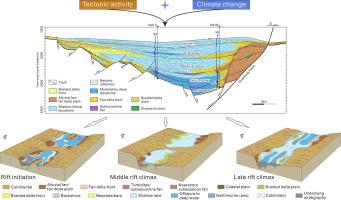当前位置:
X-MOL 学术
›
J. Asian Earth Sci.
›
论文详情
Our official English website, www.x-mol.net, welcomes your feedback! (Note: you will need to create a separate account there.)
Rift-related sedimentary evolution and its response to tectonics and climate changes: A case study of the Guaizihu sag, Yingen-Ejinaqi Basin, China
Journal of Asian Earth Sciences ( IF 3 ) Pub Date : 2020-06-01 , DOI: 10.1016/j.jseaes.2020.104370 Yunchao Hou , Hongyu Wang , Tailiang Fan , Hongan Zhang , Runze Yang , Yifan Li , Shengfang Long
Journal of Asian Earth Sciences ( IF 3 ) Pub Date : 2020-06-01 , DOI: 10.1016/j.jseaes.2020.104370 Yunchao Hou , Hongyu Wang , Tailiang Fan , Hongan Zhang , Runze Yang , Yifan Li , Shengfang Long

|
Abstract Distinguished from most existing rift basin evolutionary models, the succession of deep-water deposits in the Guaizihu sag were mainly developed during rift initiation instead of the greatest tectonic subsidence phase. This paper focuses on the detailed analysis of rift-related sequence stratigraphy and sedimentary evolution in this continental rift sag, and discusses tectonic and climatic controls on filling patterns. The deposits of the Guaizihu sag can be ascribed to four major depositional systems: alluvial fan and fan delta, braided delta, sublacustrine fan and shallow to deep lacustrine deposits. They are in part contemporaneous and some succeeding each other, forming five sequence units and corresponding substages of basin evolution: (i) rift initiation, (ii) early rift climax, (iii) middle rift climax, (iv) late rift climax, and (v) late syn-rift substages. With the onset of fault movement and hot-humid climate conditions, the first substage is characterized by a number of poorly linked depocenters, which consist of alluvial fan, fan delta and deep lacustrine deposits with organic-rich mudstones. The second substage is associated with an enhanced activity of border faults and block rotation. This unit is dominated by lacustrine deposits, but fan or braided delta and sublacustrine fans also can be observed. The third substage is marked by the maximum subsidence rate and shallow lakes fringed by fan and braided deltas. The arid environment is likely to be the main factor controlling the lithofacies and filling characteristics of this unit. During the fourth substage two early sub-sags gradually converged to form a uniform one. The relative tectonic quiescence and climate fluctuations (sub-humid to sub-arid) favored carbonate deposition. The late syn-rift unit, which is dominated by fine-grained deposits, is a consequence of degradation of source area (mostly tectonic). This study shows that the effects of tectonics and climate on lacustrine sedimentation are intimately interwoven. Tectonism determines the sag structure, stratigraphic architecture, and spatial distribution pattern of depositional systems. Climatic conditions superimposed on tectonics tends to be the major control on sediment supply, lithofacies types and sedimentary features.
更新日期:2020-06-01



























 京公网安备 11010802027423号
京公网安备 11010802027423号